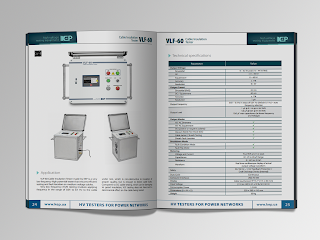 |
KEP Product Catalogue |
What is VLF Hipot Testing
Withstand or hipot testing is used to evaluate the condition of a cable insulation during installation, acceptance, or maintenance testing. As a result of a hipot test, at the point of an insulation defect an electrical tree will start to progress, create the insulation breakdown and make it possible for the technician to pinpoint the faulted place.As a result of a hipot test, at the point of an insulation defect an electrical tree will start to progress, create the insulation breakdown and make it possible for the technician to pinpoint the faulted place.
The main focus of this article is the very low frequency (VLF) withstand cable test, which essentially is a type of AC hipot test conducted at a frequency rate of 0.01 to 1.00 Hz. Due to a significant drop in the operation frequency compared to AC hipot testing, done at 50 or 60 Hz, a VLF hipot tester is much smaller than a typical AC hipot test set, and thus is widely applicable for field usage.
Main VLF Hipot Testing Parameters: Waveform, Voltage, Duration
The typical waveforms for VLF testing include the sinewave, squarewave, and cosine-rectangular (trapezoidal) wave. The sinewave, or sinusoidal voltage, is the same as the voltage used by AC power systems. Out of the three mentioned waveforms, the sinewave is found to be the most efficient for cable testing as it causes the electrical tree to progress at the fastest rate, which results in shorter test times.IEEE 400.2 guide stipulates that the test voltage should be 2.0 to 3.0 times the cables’ normal line to ground voltage. Since maintenance testing is done on service age cables, the recommended voltage is 80 per cent of that used for installation/acceptance testing. If there is a need to perform several test cycles, it may be reasonable to decrease the testing voltage by a further 20 per cent. The table below reflects the IEEE 400.2 guidelines as to the optimal testing sinewave voltage for 5 kV to 35 kV cables.
Table 1. VLF test voltage
Cable rms voltage | Installation rms / peak voltage | Acceptance rms / peak voltage | Maintenance rms / peak voltage |
5 kV | 9 / 13 kV | 10 / 14 kV | 7 / 10 kV |
8 kV | 11 / 16 kV | 13 / 18 kV | 10 / 14 kV |
15 kV | 18 / 25 kV | 20 / 28 kV | 16 / 22 kV |
25 kV | 27 / 38 kV | 31 / 44 kV | 23 / 33 kV |
35 kV | 39 / 55 kV | 44 / 62 kV | 33 / 47 kV |
The advised testing time is 60 minutes at 0.1 Hz on new cables, and 30 minutes at 0.1 Hz on service age cables; it is recommended that the withstand testing time during maintenance testing should be extended to 60 minutes at 0.1 Hz if the circuit in question is of special importance.
VLF Testing Method
VLF testing is performed on offline cables, that is, the cable under test should be disconnected from the power system, and properly grounded. The VLF tester is then connected to the cable under test, and the required test voltage is set.If the cable under test passes the VLF testing, the voltage should be decreased to zero, the cable under test and the VLF instrument should be discharged, and the cable should be grounded.
If the cable under test fails the test, the test voltage drops down to zero on its own. The VLF tester should be switched off for the cable and the tester to discharge, and the cable should be grounded. After that, the fault or faults can be found with fault locating instruments and repaired, or the respective cable sections are replaced.
 |
Connection Setup for a VLF Cable |
Advantages and Disadvantages of VLF Cable Testing
The strong points of VLF cable testing include the following:- VLF cable testing is applicable for extruded polyethylene, laminated paper, and mixed insulation;
- the small size of the VLF test set is perfect for field testing;
- VLF hipot testing can be done on both new and service age cables, which means that it can be used for installation, acceptance, and maintenance testing;
- With the right voltage and testing time, VLF testing is not destructive for less severe insulation defects that could remain dormant for a long time and not impede the cable performance. Yet, it is efficient for locating more severe insulation defects that are likely to cause cable faults in the nearest future;
- Combined with standard cable diagnostics equipment, the VLF test set can be used for diagnostic testing.
- VLF withstand testing may not provide conclusive results if the insulation is significantly damaged by water treeing or has partial discharges. In this situation, it is recommended that VLF testing should be combined with other diagnostic testing methods;
- VLF testing with very high testing voltage at a frequency below 0.01 Hz may cause space charges in extruded polyethylene insulation;
- VLF cable testing is done on offline cables only.
Alexei Tiatiushkin
Marketing manager
KharkovEnergoPribor Ltd.
marketing@keppowertesting.uk
http://www.kep.ua
Comments
Post a Comment